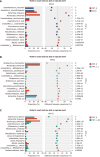Intestinal microecological transplantation for a patient with chronic radiation enteritis: A case report
- PMID: 38817661
- PMCID: PMC11135409
- DOI: 10.3748/wjg.v30.i19.2603
Intestinal microecological transplantation for a patient with chronic radiation enteritis: A case report
Abstract
Background: The gut microbiota is strongly associated with radiation-induced gut damage. This study aimed to assess the effectiveness and safety of intestinal microecological transplantation for treating patients with chronic radiation enteritis.
Case summary: A 64-year-old female with cervical cancer developed abdominal pain, diarrhea, and blood in the stool 1 year after radiotherapy. An electronic colonoscopy was performed to diagnose chronic radiation enteritis. Two courses of intestinal microecological transplantation and full-length 16S rRNA microbiological analysis were performed. The patient experienced short- and long-term relief from symptoms without adverse effects. Whole 16S rRNA sequencing revealed significant differences in the intestinal flora's composition between patient and healthy donors. Pathogenic bacteria, such as Escherichia fergusonii and Romboutsia timonensis, were more in the patient. Beneficial bacteria such as Faecalibacterium prausnitzii, Fusicatenibacter saccharivorans, Ruminococcus bromii, and Bifidobacterium longum were more in the healthy donors. Intestinal microbiota transplantation resulted in a significant change in the patient's intestinal flora composition. The composition converged with the donor's flora, with an increase in core beneficial intestinal bacteria, such as Eubacterium rectale, and a decrease in pathogenic bacteria. Changes in the intestinal flora corresponded with the patients' alleviating clinical symptoms.
Conclusion: Intestinal microecological transplantation is an effective treatment for relieving the clinical symptoms of chronic radiation enteritis by altering the composition of the intestinal flora. This study provides a new approach for treating patients with chronic radiation enteritis.
Keywords: Cancer; Case report; Chronic radiation enteritis; Gut microbial transplantation; Intestinal microecology; Quality of life.
©The Author(s) 2024. Published by Baishideng Publishing Group Inc. All rights reserved.
Conflict of interest statement
Conflict-of-interest statement: The authors declare no conflict of interest.
Figures





Similar articles
-
Screening of biomarkers in acute radiation enteritis based on microbiome and clustering methods.BMC Microbiol. 2024 Nov 8;24(1):463. doi: 10.1186/s12866-024-03620-x. BMC Microbiol. 2024. PMID: 39516773 Free PMC article.
-
[Analysis of short-term efficacy of perioperative fecal microbiota transplantation combined with nutritional support in patients with radiation-induced enteritis complicated by intestinal obstruction].Zhonghua Wei Chang Wai Ke Za Zhi. 2023 Oct 25;26(10):955-962. doi: 10.3760/cma.j.cn441530-20230816-00052. Zhonghua Wei Chang Wai Ke Za Zhi. 2023. PMID: 37849266 Clinical Trial. Chinese.
-
Treatment of Radiation Enteritis With Fecal Transplantation.Am Surg. 2023 Jun;89(6):2999-3001. doi: 10.1177/00031348221091954. Epub 2022 Jun 12. Am Surg. 2023. PMID: 35695221
-
The Impact of Gut Microbiota on Radiation-Induced Enteritis.Front Cell Infect Microbiol. 2021 Jul 29;11:586392. doi: 10.3389/fcimb.2021.586392. eCollection 2021. Front Cell Infect Microbiol. 2021. PMID: 34395308 Free PMC article. Review.
-
Microbiome and Abdominopelvic Radiotherapy Related Chronic Enteritis: A Microbiome-based Mechanistic Role of Probiotics and Antibiotics.Am J Clin Oncol. 2024 May 1;47(5):246-252. doi: 10.1097/COC.0000000000001082. Epub 2024 Jan 9. Am J Clin Oncol. 2024. PMID: 38193365 Review.
Cited by
-
The gut microbiome and cancer: from tumorigenesis to therapy.Nat Metab. 2025 May;7(5):895-917. doi: 10.1038/s42255-025-01287-w. Epub 2025 May 6. Nat Metab. 2025. PMID: 40329009 Review.
-
The characteristics of tissue microbiota in different anatomical locations and different tissue types of the colorectum in patients with colorectal cancer.mSystems. 2025 Jun 17;10(6):e0019825. doi: 10.1128/msystems.00198-25. Epub 2025 May 27. mSystems. 2025. PMID: 40422085 Free PMC article.
-
The Interplay Between the Gut Microbiota and Colorectal Cancer: A Review of the Literature.Microorganisms. 2025 Jun 17;13(6):1410. doi: 10.3390/microorganisms13061410. Microorganisms. 2025. PMID: 40572299 Free PMC article. Review.
-
Microbiome in radiotherapy: an emerging approach to enhance treatment efficacy and reduce tissue injury.Mol Med. 2024 Jul 19;30(1):105. doi: 10.1186/s10020-024-00873-0. Mol Med. 2024. PMID: 39030525 Free PMC article. Review.
References
-
- Paquette IM, Vogel JD, Abbas MA, Feingold DL, Steele SR Clinical Practice Guidelines Committee of The American Society of Colon and Rectal Surgeons. The American Society of Colon and Rectal Surgeons Clinical Practice Guidelines for the Treatment of Chronic Radiation Proctitis. Dis Colon Rectum. 2018;61:1135–1140. - PubMed
-
- Demers M, Dagnault A, Desjardins J. A randomized double-blind controlled trial: impact of probiotics on diarrhea in patients treated with pelvic radiation. Clin Nutr. 2014;33:761–767. - PubMed
-
- Garcia-Peris P, Velasco C, Hernandez M, Lozano MA, Paron L, de la Cuerda C, Breton I, Camblor M, Guarner F. Effect of inulin and fructo-oligosaccharide on the prevention of acute radiation enteritis in patients with gynecological cancer and impact on quality-of-life: a randomized, double-blind, placebo-controlled trial. Eur J Clin Nutr. 2016;70:170–174. - PubMed

